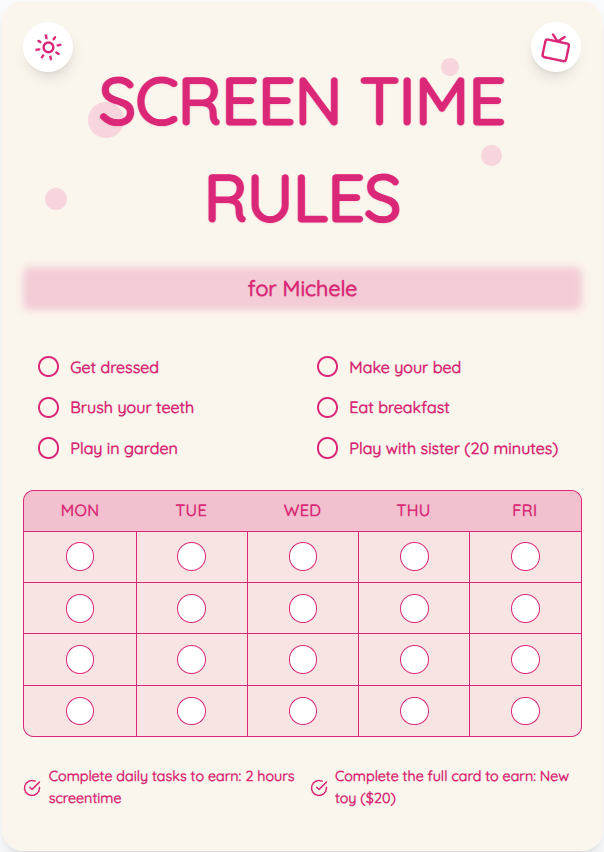Understanding Recommended Screen Time for Adults
As adults, managing screen time is crucial for our overall well-being and productivity. In this guide, we explore the recommended guidelines for adult screen time and provide actionable tips to help you find the right balance in a digital world.
See What Your Screen Time Chart Will Look Like
Here's an example of a beautiful, customizable screen time rules chart you can create for your family

Why Screen Time Limits Matter
Excessive screen time can lead to various health issues such as eye strain, poor posture, sleep disturbances, and decreased physical activity. Setting limits on screen time can help improve mental health, relationships, and overall quality of life. It's essential to be mindful of our technology use to maintain a healthy lifestyle.
Recommended Screen Time Guidelines for Adults
While there is no specific one-size-fits-all recommendation for adults, experts suggest limiting recreational screen time to around 2 hours per day. However, work-related screen time may vary based on individual job requirements. It's important to assess your screen time habits and make adjustments to prioritize activities that promote well-being.
Put These Tips Into Action
Create a custom chart to implement these strategies with your child
Practical Tips to Manage Screen Time
1. Set specific time limits for different types of screen activities. 2. Take regular breaks to rest your eyes and stretch your body. 3. Engage in non-screen activities like reading, exercising, or spending time outdoors. 4. Use screen time tracking apps to monitor and control your usage. 5. Create tech-free zones in your home to encourage offline interactions. 6. Prioritize quality screen time over quantity by choosing meaningful content.
Practical Tips for Success
- Set specific time limits for different types of screen activities.
- Take regular breaks to rest your eyes and stretch your body.
- Engage in non-screen activities like reading, exercising, or spending time outdoors.
- Use screen time tracking apps to monitor and control your usage.
Frequently Asked Questions
Is there an ideal screen time limit for adults?
While recommendations vary, limiting recreational screen time to around 2 hours per day is a good starting point. However, it's essential to find a balance that works best for your lifestyle and well-being.
How can excessive screen time affect adults?
Excessive screen time can lead to physical health issues like eye strain and poor posture, as well as mental health concerns such as increased stress and decreased productivity. Setting limits and practicing mindful tech use can help mitigate these effects.
What are some strategies for reducing screen time as an adult?
Some effective strategies include setting daily screen time goals, scheduling tech-free activities, using productivity tools to limit distractions, and seeking alternative hobbies that don't involve screens. It's important to gradually reduce screen time to create sustainable habits.
Finding the right balance with screen time is essential for maintaining a healthy lifestyle. By implementing practical tips and being mindful of your technology use, you can enjoy the benefits of digital devices while prioritizing your well-being. Explore our screen time charts at ScreenTimeRules.com to create a customized plan for managing your screen time effectively.
Ready to Transform Your Family's Screen Time?
Join thousands of parents who have successfully managed screen time with our customizable charts.
